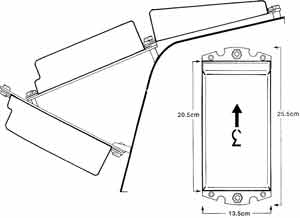| Designation: | Kontact V |
 |
|---|---|---|
| Manufacturer: | OJSC NII Stali | |
| Product type: | Ballistic Protection | |
| Name: | Explosive reactive armour |
Since the early 1980s the Soviet Union (now the Russian Federation and Associated States (CIS)) has been fitting Explosive Reactive Armour (ERA) packages onto its MBTs to increase their battlefield survivability against ATGWs that rely on High Explosive Anti-Tank (HEAT) warheads to achieve armour penetration.
Development of Russian ERA took place in the 1970s but a decision was not taken to deploy it with front line units until it was observed on Israeli MBTs in 1998. In January 1983, a decision was taken to adopt ERA and in September the same year the first tanks fitted with ERA started to leave the factories.
From 1984, T-64/T-80 MBTs deployed in the then Group of Soviet Forces Germany started to receive ERA packages. More recently T-72s and some T-55s (such as those used by the naval infantry) have also been fitted with ERA packages.
The basic principles of ERA are given in the entry for the Israeli Blazer system in this section.
There are two types of ERA block: the first is the standard shoebox type which has overall dimensions of approximately 25.5 x 13.5 cm; the second is a wedge type block. Both have an arrow indicating how they should be installed to provide the maximum level of protection.
The standard ERA block has an ERA element (for example, two plates of steel separated by explosive) which can be installed in one of two positions for maximum protection. The wedge type has a fixed ERA element.
Each panel measures about 250 x 150 x 70 mm and has four bolt holes, one at each corner, to attach one brick to each corner. Located centrally on the edge of each brick is a pair of mounting pins enabling it to be attached to the tank's main armour.
The ERA panels are placed at varying distances away from the basic armour of the tank. The configuration of the panels differs between the various types of MBT from T-64B to the T-80. While the configuration of the hull glacis panels is identical, there are significant differences on those attached to the turret and hull sides.
Both the T-64 and T-80 have hulls and turrets of advanced armour construction. The glacis plate of these, for example, is 200 mm thick at an angle of 22° to the horizontal. It consists of two layers of steel, a layer of glass fibre, a layer of steel and finally a lead-impregnated plastic foam liner. The nose of the tank is similar but does not have the glass fibre or third layer of steel. When fitted with ERA these tanks are invulnerable to many current NATO anti-tank weapons, both Kinetic Energy (KE) and Chemical Energy (CE), over their frontal arc.
The latest upgraded version of the T-80 MBT, called the T-80U by the RFAS, has a new and different armour package. This includes a new type of ERA box, armoured side skirts complete with lifting handles covering the upper sides of the hull and suspension and what appears to be a rubber or metal flap which is at an angle of 45°. This flap covers the gap between the turret front and the top of the hull and may well be a fixture to deflect top attack weapons using bomblets or other types of submunitions.
The RFAS has also deployed ERA on some of its T-55 MBTs which have already been upgraded in a number of other areas including the installation of a laser range-finder. These have been identified as being in service with naval infantry units. Tanks with ERA normally have a V in their designation, for example T-64BV, T-64BV1K, T-55MV and T-55MVK, however, the new T-80 is known as the T-80U.
Syria has now taken delivery of some T-55 series MBTs from the Ukraine, fitted with ERA over their frontal arc.
The latest production versions of the T-72 and T-80 MBTs are fitted with a new generation ERA that provides protection against both CE and KE attack.
Second-generation ERA packages that provide protection against both CE and KE attack are fitted to the latest production RFAST-90 MBT and the T-84 MBT which has been designed and built in the Ukraine and is still at the prototype stage.
Late in 1993, the RFAS released details of the Contact ERA package which is being marketed to provide armoured fighting vehicles and bunkers with a high level of protection against attack from weapons fitted with a HEAT warhead.
Typically, penetration is claimed to be reduced by between 70 and 95 per cent. The Contact package cannot be activated by small arms fire up to 12.7 mm in calibre and can be fitted onto vehicles with simple tools.
Each Contact explosive reactive element consists of a universal box containing two universal explosive reactive elements with an MBT typically having between 200 and 300 universal boxes per vehicle.
More recently, details of two additional ERA blocks have been released. The first of these is claimed to give protection against both HEAT and Armour-Piercing Fin Stabilised Discarding Sabot (APFSDS) projectiles. Each box is 250 x 130 x 10 mm and weighs 1.35 kg. The box itself is steel with plastic explosive inside.
The second is 314 x 138 mm including the mounting lugs when viewed from the top, with the box for the ERA element being 250 mm long and 106 mm high.
The 'Heavy' Contact ERA Package is also referred as Contact 5 and started to be fitted in 1985. It provides protection against both HE and HEAT attack.
|
||||||||||||
 |
 |
 |
